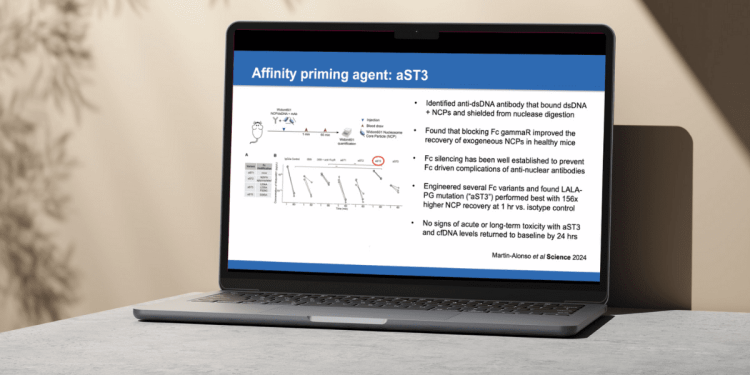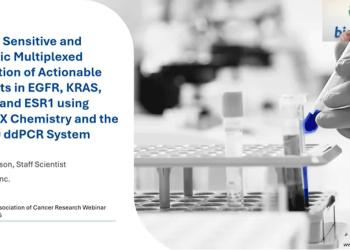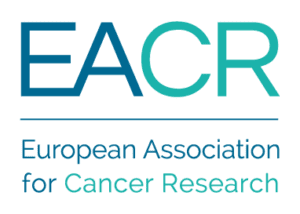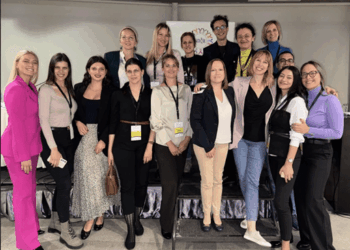For the EACR, the conference season started this year with a joint EACR-AstraZeneca Conference, Circulating Nucleic Acids (cfDNA/ctDNA): In use, in view and on the horizon, on 28 – 29 January 2025. After a very successful conference discussing the breath and promises of Liquid Biopsies in November last year, this virtual event took a focused look at circulating nucleic acids and their promise for cancer diagnostic and disease monitoring (MRD).
Over the course of two afternoons, 142 attendees from 26 countries had the opportunity to gain a holistic understanding of circulating nucleic acids, how they are built into clinical trial designs to inform patient management, the multiple measurements possible to gain the most information from a blood sample and the direction of travel for this exciting field.
The scientific programme, made up of renowned speakers in the field, was praised by participants for its “insightful and innovative talks” covering cutting-edge topics. Dr. Alexandra Boitor, EACR Scientific Officer, summarises here the main scientific takeaways from this meeting.
The conference debuted with a keynote lecture from Dr Yuval Dor from the Hebrew University of Jerusalem (Israel), who spoke on the epigenetic aspect of liquid biopsies. In his talk, Dr Dor focused on the use of DNA methylation patterns. The talk began with a short overview of cfDNA uses in liquid biopsies in general, highlighting the potential use of methylation patterns for the detection of cancer and inferring information on the tissue of origin, chronologic and epigenetic age, environmental exposures and toxicity [1]. This information can be extracted from the methylation profile of cfDNA because methylation patterns are largely conserved among cells of the same type in all individuals. However, in order to be able to identify changes, we first need a reference methylome map. This is exactly what Dr Dor’s lab set out to do in partnership with GRAIL. They started working on a DNA methylation atlas of normal human cell types, a still ongoing effort in the lab [2, 3]. In his talk, Prof Dor discussed the key applications of the DNA methylation atlas from the deconvolution of the untargeted cfDNA methylome [3] and identification of cell-type specific methylation markers [3] to the detection and prediction of cancer progression [4] or the monitoring of immune cell dynamics in immunotherapy [5](using multiple myeloma [4] and interstitial lung disease [5] as examples).
Further on, with world-leading expert speakers, the conference set to discuss other current clinical utilities of ctDNA and cfDNA based liquid biopsies (with examples in breast, lung, colorectal and bladder cancers), from the opportunities and challenges of cancer early detection and disease monitoring with minimally invasive approaches to next generation technologies on the horizon for liquid biopsy. The general sentiment was that substantial progress has been made in this field; however, higher sensitivity is needed for the currently available assays. Dr Viktor Adalsteinsson, the director of the Gerstner Center for Cancer Diagnostics at the Broad Institute of MIT and Harvard (USA), presented a method his team developed to improve sensitivity of cfDNA MRD testing without compromising specificity [6-9]. Dr Davina Gale, director of Translational Medicine and Cancer Biomarker Development at Astra Zeneca (UK) emphasised that the ‘perfect’ ctDNA assay for all clinical applications does not yet exist and discussed the different requirements that ctDNA assays need for different clinical applications.
Further on, Dr Gale explained the AstraZeneca Oncology R&D strategy to transform cancer outcomes starting from the identification of high-risk early-stage patients on the basis of ctDNA and continuing to MRD monitoring, bringing into question the possibility of de-escalating treatment. Dr Gale presented as supporting evidence the latest (still unpublished) updates from the AEGEAN [10] and the DYNAMIC clinical trials [11].
On the topic of clinical trials, Dr Silvia Marsoni from IFOM, Milan, Italy, presented her journey, including achievements and challenges, integrating ctDNA based liquid biopsies in the management of colorectal cancer. Dr Marsoni’s research is looking at using MRD detection to predict disease outcome and guide treatment decisions. Her presentation focused on the PEGASUS [12, 13] and SAGITTARIUS [14] trial from study design to the latest patient data. In the second part of her presentation, Dr Marsoni looked at how liquid biopsies in general and results from those clinical trials in particular could be used to better our understanding of the biology of colon cancer.
The closing keynote at this conference focused on early detection of cancer using cell-free DNA fragmentomes. In his talk, Dr Victor Velculescu from Johns Hopkins University School of Medicine (USA), explained the limitations of looking at mutations at cfDNA in the blood and proposed an alternative, looking at the chromatin changes of cfDNA. His lab is taking a brother approach that relies on whole genome sequencing and is looking at the sequencing profile of all fragments of cfDNA in the blood stream. White blood cells would have a different profile than tumour cells because their chromatin is packed in a similar way, leading to consistent nucleosomal patterns, whilst tumour cfDNA usually comes from dying cells and is partially degraded and has lost much of its 3D organisation [15]. Differences in this profile can reveal information on the chromatin, genome, epigenome and transcriptional state of the cells that shed the DNA into the bloodstream [15-19].
The conference concluded with a panel discussion where Scientific Programme Committee members Dr Silvia Marsoni (IFOM), Dr Caroline Dive (CRUK Manchester), Dr James Hadfield (AstraZeneca) and Dr Davina Gale (AstraZeneca) reflected on the clinical implementation of circulating nucleic acids and the new technologies on the horizon.
EACR Conferences
At the EACR we are dedicated to providing excellent cancer research conferences where the latest research topics and interaction for participants are the very highest priorities. Make sure you add the dates of the upcoming EACR Conferences to your diary now. Don’t forget we offer member discounts on all of our registration fees!
References
- Lo, Y.M.D., et al., Epigenetics, fragmentomics, and topology of cell-free DNA in liquid biopsies.Science, 2021. 372(6538).
- Moss, J., et al., Comprehensive human cell-type methylation atlas reveals origins of circulating cell-free DNA in health and disease. Nature Communications, 2018. 9(1): p. 5068.
- Loyfer, N., et al., A DNA methylation atlas of normal human cell types. Nature, 2023. 613(7943): p. 355-364.
- Gatt, M.E., et al., Plasma Cell Specific cfDNA Methylation Patterns Differentiate MGUS, SMM and MM and Predict Biochemical and Clinical Progression to MM. Blood, 2024. 144: p. 1016.
- Grinshpun, A., et al., Detection of antibody–drug conjugate-induced interstitial lung disease using circulating cell-free DNA. ESMO Open, 2024. 9(10).
- Blewett, T., et al., MAESTRO-Pool Enables Highly Parallel and Specific Mutation-Enrichment Sequencing for Minimal Residual Disease Detection in Cohort Studies. Clin Chem, 2024. 70(2): p. 434-443.
- Martin-Alonso, C., et al., Priming agents transiently reduce the clearance of cell-free DNA to improve liquid biopsies. Science. 383(6680): p. eadf2341.
- Sim, E.S., et al., Immediate postoperative minimal residual disease detection with MAESTRO predicts recurrence and survival in head and neck cancer patients treated with surgery. medRxiv, 2025: p. 2025-01.
- Krasnow, N., et al., Early Measurable Residual Disease Detection after CAR-T is Associated with Poor Outcomes in Patients with Large B-cell Lymphoma. medRxiv, 2024: p. 2024-11.
- Heymach John, V., et al., Perioperative Durvalumab for Resectable Non–Small-Cell Lung Cancer.New England Journal of Medicine, 2023. 389(18): p. 1672-1684.
- Tie, J., et al., Circulating Tumor DNA Analysis Guiding Adjuvant Therapy in Stage II Colon Cancer.New England Journal of Medicine, 2022. 386(24): p. 2261-2272.
- Lonardi, S., et al., LBA28 The PEGASUS trial: Post-surgical liquid biopsy-guided treatment of stage III and high-risk stage II colon cancer patients. Annals of Oncology, 2023. 34: p. S1268-S1269.
- 2020; Available from: https://www.clinicaltrialsregister.eu/ctr-search/trial/2019-002074-32/IT/.
- 2024; Available from: https://sagittarius-horizon.eu/en/sagittarius-marks-its-official-start/.
- Cristiano, S., et al., Genome-wide cell-free DNA fragmentation in patients with cancer. Nature, 2019. 570(7761): p. 385-389.
- Mathios, D., et al., Detection and characterization of lung cancer using cell-free DNA fragmentomes.Nature Communications, 2021. 12(1): p. 5060.
- Noë, M., et al., DNA methylation and gene expression as determinants of genome-wide cell-free DNA fragmentation. Nature Communications, 2024. 15(1): p. 6690.
- Annapragada, A.V., et al., Genome-wide repeat landscapes in cancer and cell-free DNA. Sci Transl Med, 2024. 16(738): p. eadj9283.
- Mazzone, P.J., et al., Clinical Validation of a Cell-Free DNA Fragmentome Assay for Augmentation of Lung Cancer Early Detection. Cancer Discovery, 2024. 14(11): p. 2224-2242.









